Global Corporate Strategy assignment : Tata Group
VerifiedAdded on 2021/05/31
|19
|4737
|172
AI Summary
Contribute Materials
Your contribution can guide someone’s learning journey. Share your
documents today.
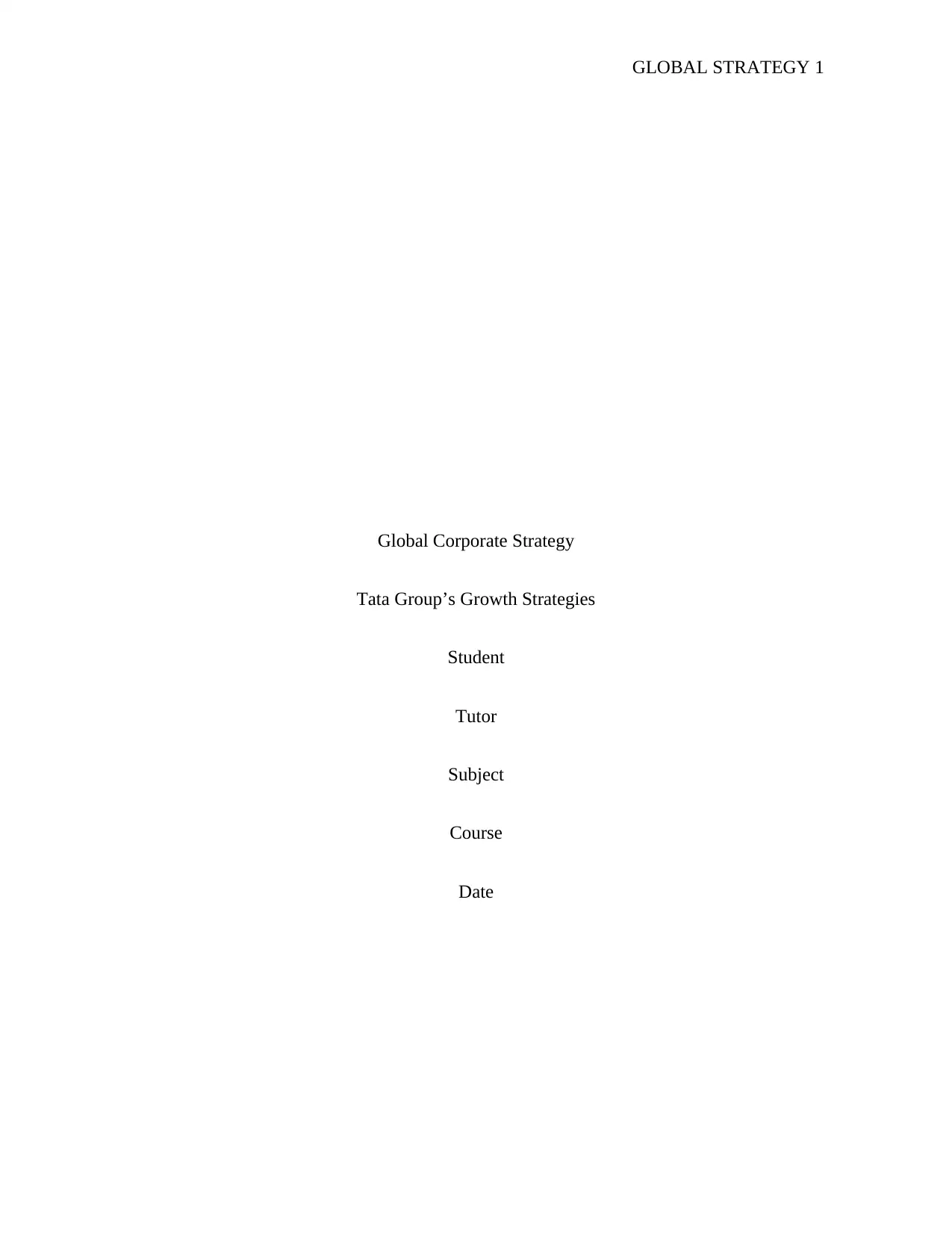
GLOBAL STRATEGY 1
Global Corporate Strategy
Tata Group’s Growth Strategies
Student
Tutor
Subject
Course
Date
Global Corporate Strategy
Tata Group’s Growth Strategies
Student
Tutor
Subject
Course
Date
Secure Best Marks with AI Grader
Need help grading? Try our AI Grader for instant feedback on your assignments.
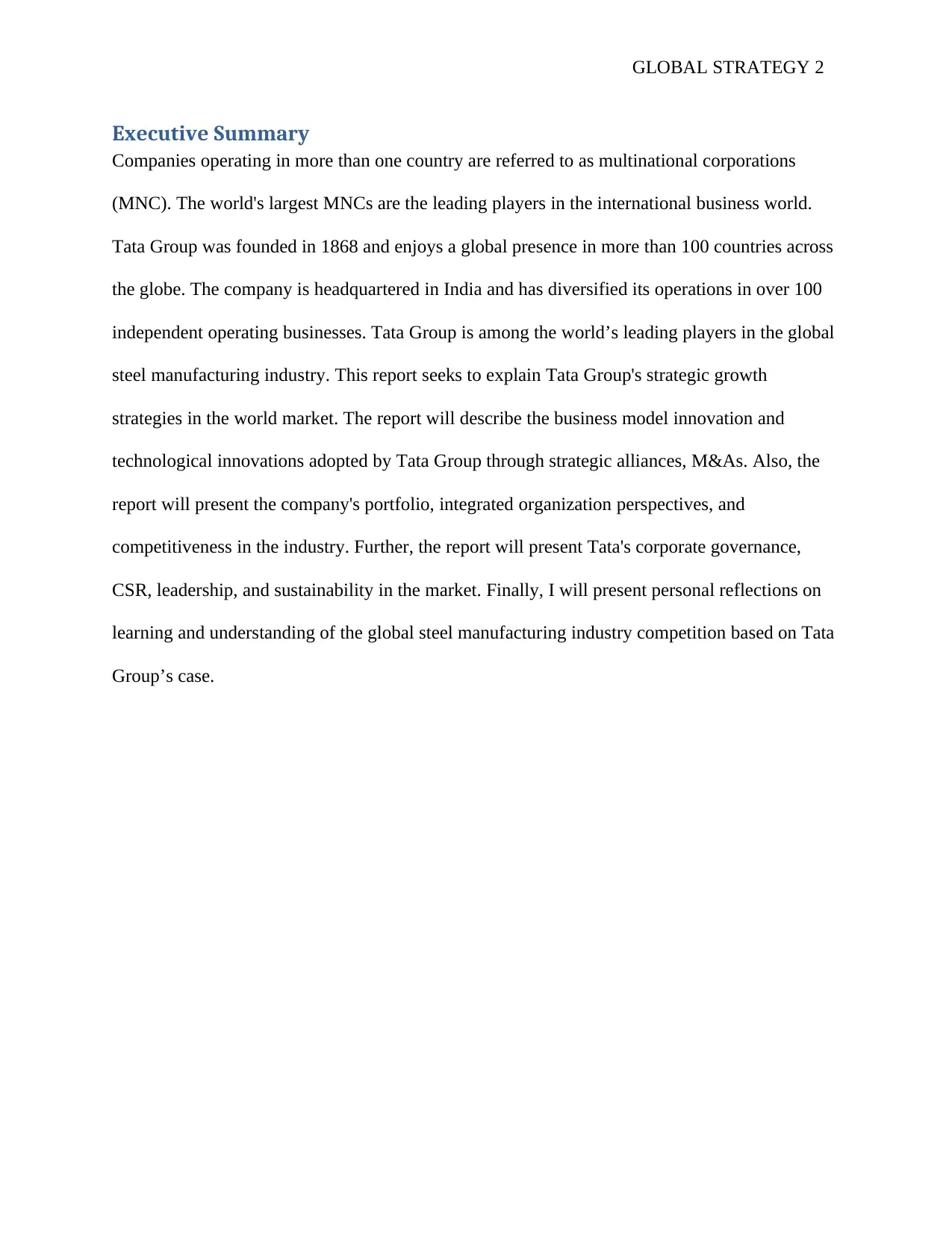
GLOBAL STRATEGY 2
Executive Summary
Companies operating in more than one country are referred to as multinational corporations
(MNC). The world's largest MNCs are the leading players in the international business world.
Tata Group was founded in 1868 and enjoys a global presence in more than 100 countries across
the globe. The company is headquartered in India and has diversified its operations in over 100
independent operating businesses. Tata Group is among the world’s leading players in the global
steel manufacturing industry. This report seeks to explain Tata Group's strategic growth
strategies in the world market. The report will describe the business model innovation and
technological innovations adopted by Tata Group through strategic alliances, M&As. Also, the
report will present the company's portfolio, integrated organization perspectives, and
competitiveness in the industry. Further, the report will present Tata's corporate governance,
CSR, leadership, and sustainability in the market. Finally, I will present personal reflections on
learning and understanding of the global steel manufacturing industry competition based on Tata
Group’s case.
Executive Summary
Companies operating in more than one country are referred to as multinational corporations
(MNC). The world's largest MNCs are the leading players in the international business world.
Tata Group was founded in 1868 and enjoys a global presence in more than 100 countries across
the globe. The company is headquartered in India and has diversified its operations in over 100
independent operating businesses. Tata Group is among the world’s leading players in the global
steel manufacturing industry. This report seeks to explain Tata Group's strategic growth
strategies in the world market. The report will describe the business model innovation and
technological innovations adopted by Tata Group through strategic alliances, M&As. Also, the
report will present the company's portfolio, integrated organization perspectives, and
competitiveness in the industry. Further, the report will present Tata's corporate governance,
CSR, leadership, and sustainability in the market. Finally, I will present personal reflections on
learning and understanding of the global steel manufacturing industry competition based on Tata
Group’s case.
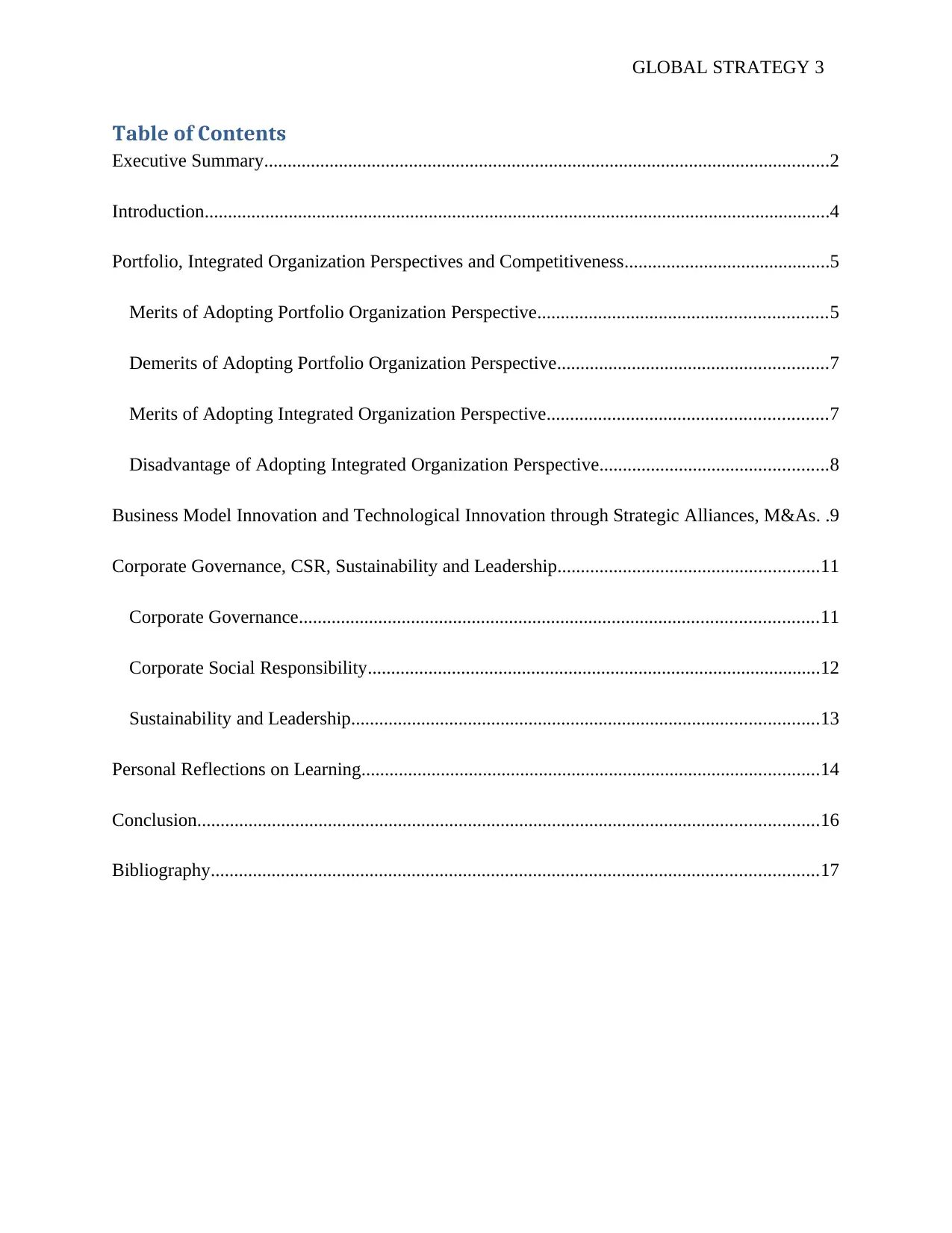
GLOBAL STRATEGY 3
Table of Contents
Executive Summary.........................................................................................................................2
Introduction......................................................................................................................................4
Portfolio, Integrated Organization Perspectives and Competitiveness............................................5
Merits of Adopting Portfolio Organization Perspective..............................................................5
Demerits of Adopting Portfolio Organization Perspective..........................................................7
Merits of Adopting Integrated Organization Perspective............................................................7
Disadvantage of Adopting Integrated Organization Perspective.................................................8
Business Model Innovation and Technological Innovation through Strategic Alliances, M&As. .9
Corporate Governance, CSR, Sustainability and Leadership........................................................11
Corporate Governance...............................................................................................................11
Corporate Social Responsibility.................................................................................................12
Sustainability and Leadership....................................................................................................13
Personal Reflections on Learning..................................................................................................14
Conclusion.....................................................................................................................................16
Bibliography..................................................................................................................................17
Table of Contents
Executive Summary.........................................................................................................................2
Introduction......................................................................................................................................4
Portfolio, Integrated Organization Perspectives and Competitiveness............................................5
Merits of Adopting Portfolio Organization Perspective..............................................................5
Demerits of Adopting Portfolio Organization Perspective..........................................................7
Merits of Adopting Integrated Organization Perspective............................................................7
Disadvantage of Adopting Integrated Organization Perspective.................................................8
Business Model Innovation and Technological Innovation through Strategic Alliances, M&As. .9
Corporate Governance, CSR, Sustainability and Leadership........................................................11
Corporate Governance...............................................................................................................11
Corporate Social Responsibility.................................................................................................12
Sustainability and Leadership....................................................................................................13
Personal Reflections on Learning..................................................................................................14
Conclusion.....................................................................................................................................16
Bibliography..................................................................................................................................17

GLOBAL STRATEGY 4
Introduction
The business world has turned out to be very competitive with most players adopting
sophisticated technologies in their day to day operations. Most multinational companies are
taking different strategies to boost and maintain their competitiveness in the global marketplace.
Global strategy by multinational companies comprises of global, transnational, and the
international approach used by these organizations in an attempt to achieve their international
expansion objective (Bruche, 2010, p. 55). On the other hand, global corporate strategy entails
the formal plan formulated by a corporation to expand its operations into multiple countries all
over the world. Multinational corporations utilize various tactics in achieving global expansion
plans, some of them include exportation, business mergers, and acquisitions, licensing, and
building strategic partnerships among other strategies. The global steel manufacturing industry is
among the world’s leading and competitive sectors, where most companies operating in the
industry are using different approaches to gain a competitive advantage over its rivals. Tata
Group is a multinational company working in the global steel manufacturing industry whose
tireless efforts in expanding its operations beyond borders is commendable (Lindgreen and
Swaen, 2010, p. 5). As a significant player in the industry, Tata Group is succeeding within the
international arena. The mission of Tata Group is improving the quality of life of the
communities it serves internationally, through establishing long-term stakeholder value creation
based on Leadership with Trust. The aim of this assignment is explaining Tata growth strategies
in the international business world.
Introduction
The business world has turned out to be very competitive with most players adopting
sophisticated technologies in their day to day operations. Most multinational companies are
taking different strategies to boost and maintain their competitiveness in the global marketplace.
Global strategy by multinational companies comprises of global, transnational, and the
international approach used by these organizations in an attempt to achieve their international
expansion objective (Bruche, 2010, p. 55). On the other hand, global corporate strategy entails
the formal plan formulated by a corporation to expand its operations into multiple countries all
over the world. Multinational corporations utilize various tactics in achieving global expansion
plans, some of them include exportation, business mergers, and acquisitions, licensing, and
building strategic partnerships among other strategies. The global steel manufacturing industry is
among the world’s leading and competitive sectors, where most companies operating in the
industry are using different approaches to gain a competitive advantage over its rivals. Tata
Group is a multinational company working in the global steel manufacturing industry whose
tireless efforts in expanding its operations beyond borders is commendable (Lindgreen and
Swaen, 2010, p. 5). As a significant player in the industry, Tata Group is succeeding within the
international arena. The mission of Tata Group is improving the quality of life of the
communities it serves internationally, through establishing long-term stakeholder value creation
based on Leadership with Trust. The aim of this assignment is explaining Tata growth strategies
in the international business world.
Secure Best Marks with AI Grader
Need help grading? Try our AI Grader for instant feedback on your assignments.
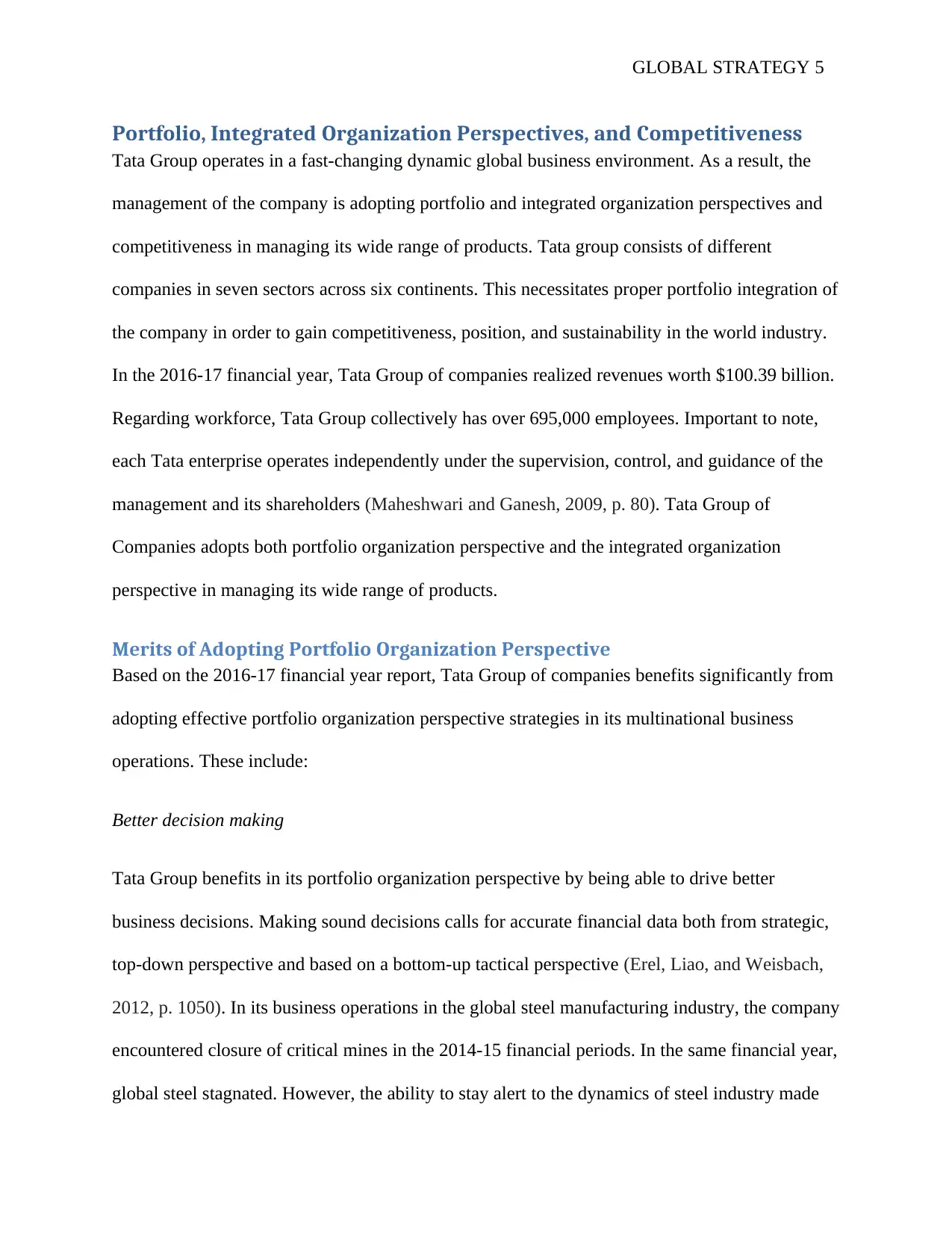
GLOBAL STRATEGY 5
Portfolio, Integrated Organization Perspectives, and Competitiveness
Tata Group operates in a fast-changing dynamic global business environment. As a result, the
management of the company is adopting portfolio and integrated organization perspectives and
competitiveness in managing its wide range of products. Tata group consists of different
companies in seven sectors across six continents. This necessitates proper portfolio integration of
the company in order to gain competitiveness, position, and sustainability in the world industry.
In the 2016-17 financial year, Tata Group of companies realized revenues worth $100.39 billion.
Regarding workforce, Tata Group collectively has over 695,000 employees. Important to note,
each Tata enterprise operates independently under the supervision, control, and guidance of the
management and its shareholders (Maheshwari and Ganesh, 2009, p. 80). Tata Group of
Companies adopts both portfolio organization perspective and the integrated organization
perspective in managing its wide range of products.
Merits of Adopting Portfolio Organization Perspective
Based on the 2016-17 financial year report, Tata Group of companies benefits significantly from
adopting effective portfolio organization perspective strategies in its multinational business
operations. These include:
Better decision making
Tata Group benefits in its portfolio organization perspective by being able to drive better
business decisions. Making sound decisions calls for accurate financial data both from strategic,
top-down perspective and based on a bottom-up tactical perspective (Erel, Liao, and Weisbach,
2012, p. 1050). In its business operations in the global steel manufacturing industry, the company
encountered closure of critical mines in the 2014-15 financial periods. In the same financial year,
global steel stagnated. However, the ability to stay alert to the dynamics of steel industry made
Portfolio, Integrated Organization Perspectives, and Competitiveness
Tata Group operates in a fast-changing dynamic global business environment. As a result, the
management of the company is adopting portfolio and integrated organization perspectives and
competitiveness in managing its wide range of products. Tata group consists of different
companies in seven sectors across six continents. This necessitates proper portfolio integration of
the company in order to gain competitiveness, position, and sustainability in the world industry.
In the 2016-17 financial year, Tata Group of companies realized revenues worth $100.39 billion.
Regarding workforce, Tata Group collectively has over 695,000 employees. Important to note,
each Tata enterprise operates independently under the supervision, control, and guidance of the
management and its shareholders (Maheshwari and Ganesh, 2009, p. 80). Tata Group of
Companies adopts both portfolio organization perspective and the integrated organization
perspective in managing its wide range of products.
Merits of Adopting Portfolio Organization Perspective
Based on the 2016-17 financial year report, Tata Group of companies benefits significantly from
adopting effective portfolio organization perspective strategies in its multinational business
operations. These include:
Better decision making
Tata Group benefits in its portfolio organization perspective by being able to drive better
business decisions. Making sound decisions calls for accurate financial data both from strategic,
top-down perspective and based on a bottom-up tactical perspective (Erel, Liao, and Weisbach,
2012, p. 1050). In its business operations in the global steel manufacturing industry, the company
encountered closure of critical mines in the 2014-15 financial periods. In the same financial year,
global steel stagnated. However, the ability to stay alert to the dynamics of steel industry made
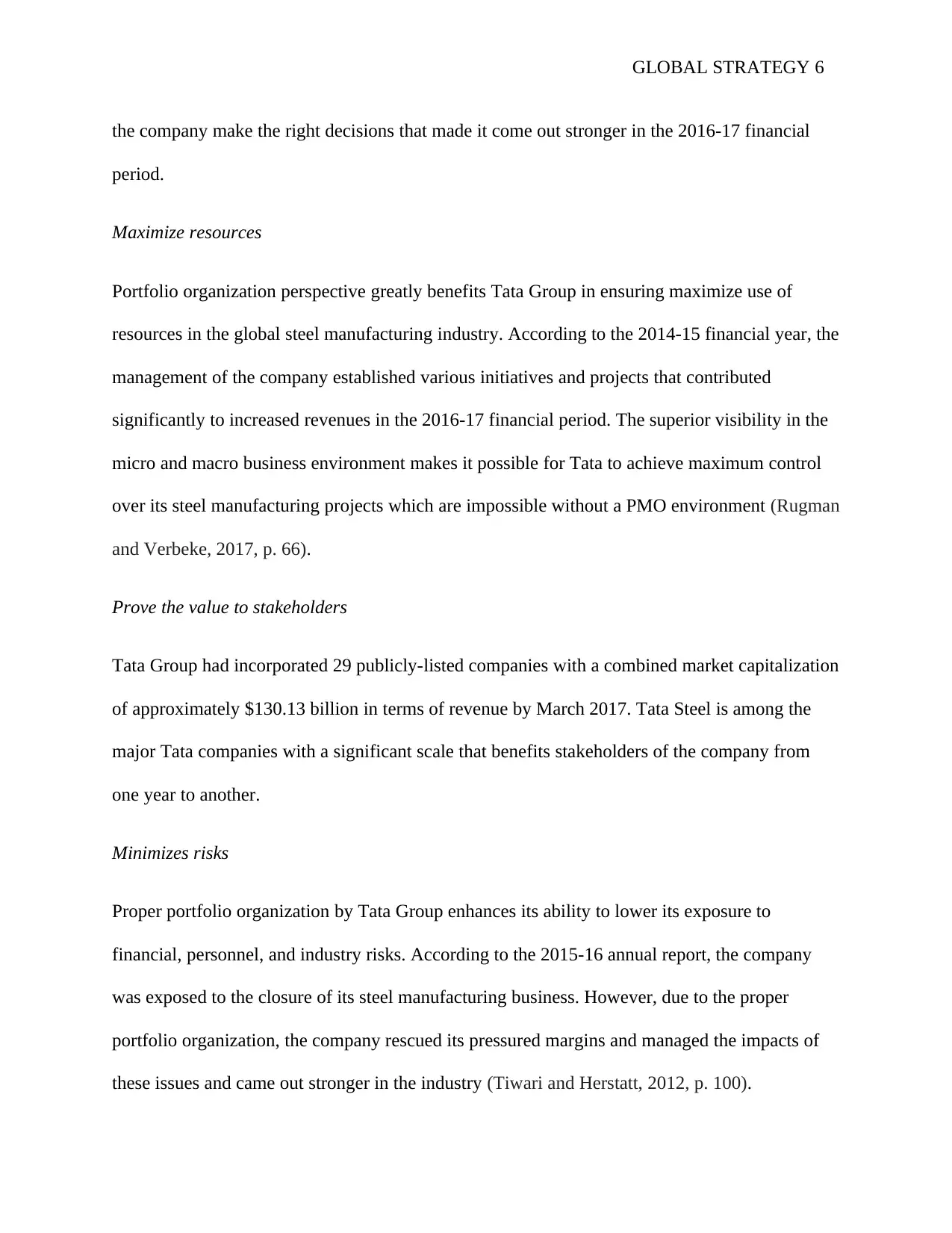
GLOBAL STRATEGY 6
the company make the right decisions that made it come out stronger in the 2016-17 financial
period.
Maximize resources
Portfolio organization perspective greatly benefits Tata Group in ensuring maximize use of
resources in the global steel manufacturing industry. According to the 2014-15 financial year, the
management of the company established various initiatives and projects that contributed
significantly to increased revenues in the 2016-17 financial period. The superior visibility in the
micro and macro business environment makes it possible for Tata to achieve maximum control
over its steel manufacturing projects which are impossible without a PMO environment (Rugman
and Verbeke, 2017, p. 66).
Prove the value to stakeholders
Tata Group had incorporated 29 publicly-listed companies with a combined market capitalization
of approximately $130.13 billion in terms of revenue by March 2017. Tata Steel is among the
major Tata companies with a significant scale that benefits stakeholders of the company from
one year to another.
Minimizes risks
Proper portfolio organization by Tata Group enhances its ability to lower its exposure to
financial, personnel, and industry risks. According to the 2015-16 annual report, the company
was exposed to the closure of its steel manufacturing business. However, due to the proper
portfolio organization, the company rescued its pressured margins and managed the impacts of
these issues and came out stronger in the industry (Tiwari and Herstatt, 2012, p. 100).
the company make the right decisions that made it come out stronger in the 2016-17 financial
period.
Maximize resources
Portfolio organization perspective greatly benefits Tata Group in ensuring maximize use of
resources in the global steel manufacturing industry. According to the 2014-15 financial year, the
management of the company established various initiatives and projects that contributed
significantly to increased revenues in the 2016-17 financial period. The superior visibility in the
micro and macro business environment makes it possible for Tata to achieve maximum control
over its steel manufacturing projects which are impossible without a PMO environment (Rugman
and Verbeke, 2017, p. 66).
Prove the value to stakeholders
Tata Group had incorporated 29 publicly-listed companies with a combined market capitalization
of approximately $130.13 billion in terms of revenue by March 2017. Tata Steel is among the
major Tata companies with a significant scale that benefits stakeholders of the company from
one year to another.
Minimizes risks
Proper portfolio organization by Tata Group enhances its ability to lower its exposure to
financial, personnel, and industry risks. According to the 2015-16 annual report, the company
was exposed to the closure of its steel manufacturing business. However, due to the proper
portfolio organization, the company rescued its pressured margins and managed the impacts of
these issues and came out stronger in the industry (Tiwari and Herstatt, 2012, p. 100).

GLOBAL STRATEGY 7
Demerits of Adopting Portfolio Organization Perspective
On the other side, the use of portfolio organization perspective disadvantages Tata Group of
companies in the segment of steel manufacturing.
Possible loss of competitiveness in the industry
The adoption of portfolio organization perspective by Tata Group exposes it to the risk of losing
competitiveness in the industry. Operating in the steel industry only could make Tata Group lose
its efficiency and productivity in the market (Dhanesh, 2015, p. 120). For example, the 2014-15
annual report shows that the company’s margins decreased due to industry challenges. This
necessitates Ta Group to integrate its segments to create a balance in its productivity.
Demand challenges
There is a possible stagnation of demand and surging of imports for the steel manufacturing
products and raw materials by Tata Group if it uses portfolio organization perspective. Before
2016, the global steel demand stagnated, and this posed a threat to Tata's sales and profitability
due to demand challenges.
Merits of Adopting Integrated Organization Perspective
Tata Group applies integrated organization perspective in successfully meshing its steel
manufacturing business with its other business portfolios such as Tata Motors, Tata Teleservices,
Indian Hotels, Tata Power, Titan, Tata Chemicals, and Tata Communications among others
(Zhang, Zhou, and Ebbers, 2011, p. 80). The major benefits of adopting integrated organization
perspective by Tata Group include:
Leadership
Demerits of Adopting Portfolio Organization Perspective
On the other side, the use of portfolio organization perspective disadvantages Tata Group of
companies in the segment of steel manufacturing.
Possible loss of competitiveness in the industry
The adoption of portfolio organization perspective by Tata Group exposes it to the risk of losing
competitiveness in the industry. Operating in the steel industry only could make Tata Group lose
its efficiency and productivity in the market (Dhanesh, 2015, p. 120). For example, the 2014-15
annual report shows that the company’s margins decreased due to industry challenges. This
necessitates Ta Group to integrate its segments to create a balance in its productivity.
Demand challenges
There is a possible stagnation of demand and surging of imports for the steel manufacturing
products and raw materials by Tata Group if it uses portfolio organization perspective. Before
2016, the global steel demand stagnated, and this posed a threat to Tata's sales and profitability
due to demand challenges.
Merits of Adopting Integrated Organization Perspective
Tata Group applies integrated organization perspective in successfully meshing its steel
manufacturing business with its other business portfolios such as Tata Motors, Tata Teleservices,
Indian Hotels, Tata Power, Titan, Tata Chemicals, and Tata Communications among others
(Zhang, Zhou, and Ebbers, 2011, p. 80). The major benefits of adopting integrated organization
perspective by Tata Group include:
Leadership
Paraphrase This Document
Need a fresh take? Get an instant paraphrase of this document with our AI Paraphraser
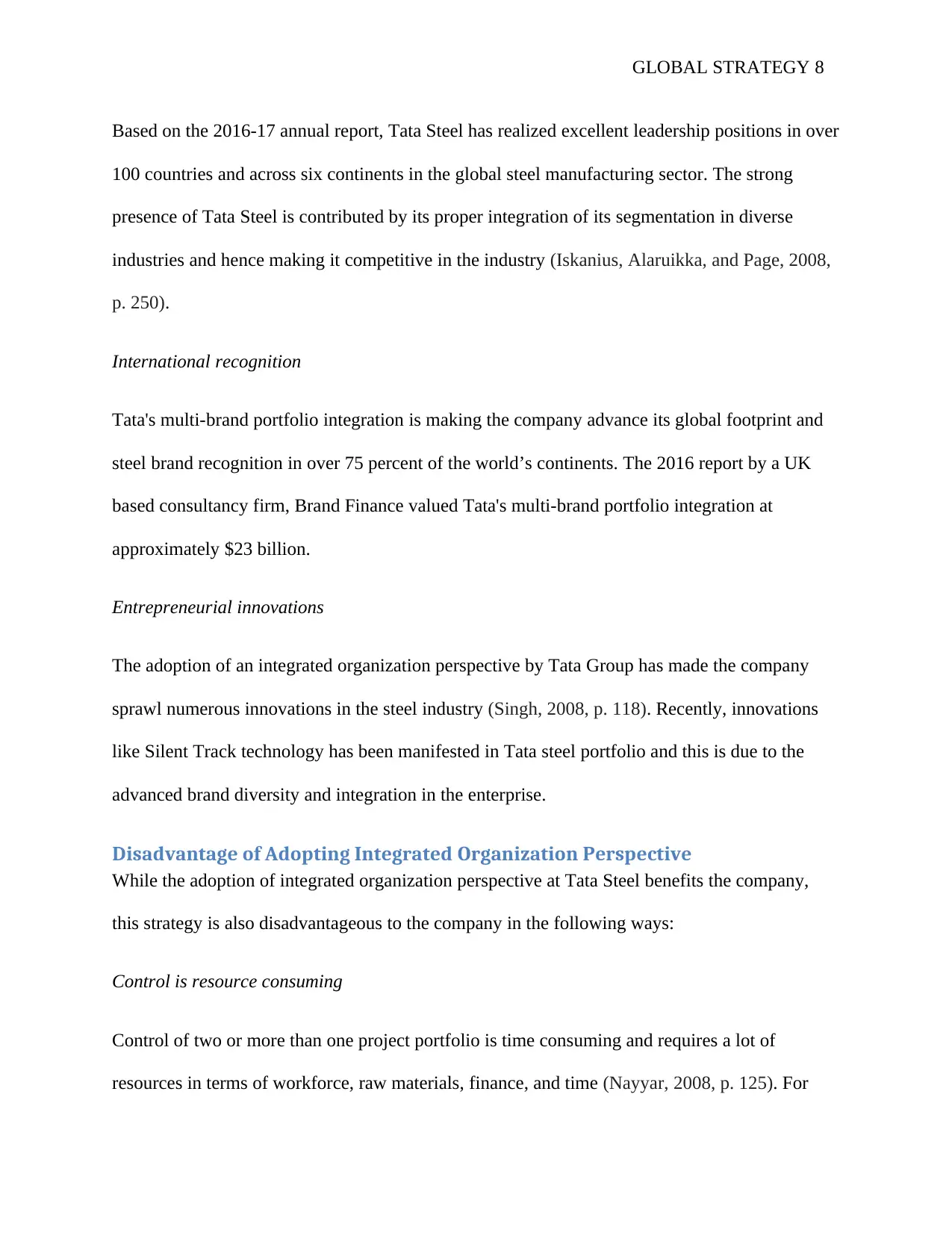
GLOBAL STRATEGY 8
Based on the 2016-17 annual report, Tata Steel has realized excellent leadership positions in over
100 countries and across six continents in the global steel manufacturing sector. The strong
presence of Tata Steel is contributed by its proper integration of its segmentation in diverse
industries and hence making it competitive in the industry (Iskanius, Alaruikka, and Page, 2008,
p. 250).
International recognition
Tata's multi-brand portfolio integration is making the company advance its global footprint and
steel brand recognition in over 75 percent of the world’s continents. The 2016 report by a UK
based consultancy firm, Brand Finance valued Tata's multi-brand portfolio integration at
approximately $23 billion.
Entrepreneurial innovations
The adoption of an integrated organization perspective by Tata Group has made the company
sprawl numerous innovations in the steel industry (Singh, 2008, p. 118). Recently, innovations
like Silent Track technology has been manifested in Tata steel portfolio and this is due to the
advanced brand diversity and integration in the enterprise.
Disadvantage of Adopting Integrated Organization Perspective
While the adoption of integrated organization perspective at Tata Steel benefits the company,
this strategy is also disadvantageous to the company in the following ways:
Control is resource consuming
Control of two or more than one project portfolio is time consuming and requires a lot of
resources in terms of workforce, raw materials, finance, and time (Nayyar, 2008, p. 125). For
Based on the 2016-17 annual report, Tata Steel has realized excellent leadership positions in over
100 countries and across six continents in the global steel manufacturing sector. The strong
presence of Tata Steel is contributed by its proper integration of its segmentation in diverse
industries and hence making it competitive in the industry (Iskanius, Alaruikka, and Page, 2008,
p. 250).
International recognition
Tata's multi-brand portfolio integration is making the company advance its global footprint and
steel brand recognition in over 75 percent of the world’s continents. The 2016 report by a UK
based consultancy firm, Brand Finance valued Tata's multi-brand portfolio integration at
approximately $23 billion.
Entrepreneurial innovations
The adoption of an integrated organization perspective by Tata Group has made the company
sprawl numerous innovations in the steel industry (Singh, 2008, p. 118). Recently, innovations
like Silent Track technology has been manifested in Tata steel portfolio and this is due to the
advanced brand diversity and integration in the enterprise.
Disadvantage of Adopting Integrated Organization Perspective
While the adoption of integrated organization perspective at Tata Steel benefits the company,
this strategy is also disadvantageous to the company in the following ways:
Control is resource consuming
Control of two or more than one project portfolio is time consuming and requires a lot of
resources in terms of workforce, raw materials, finance, and time (Nayyar, 2008, p. 125). For

GLOBAL STRATEGY 9
instance, it was difficult for Tata Group to manage the impacts of the 2014-15 and 2016
challenges of steel demand, reduced imports, and environmental problems due to the high cost of
resources.
Based on my evaluation, it is possible for Tata Group to adopt both portfolio and integrated
organization perspectives in managing its wide range of products. This is because both minimize
risks and enhance decision making hence fostering improved competitive of the company in the
steel manufacturing industry.
Business Model Innovation and Technological Innovation through
Strategic Alliances, M&As
Tata Group greatly focuses on business model innovation and technological innovation through
strategic alliances. The huge focus on model innovations by Tata Group have helped the
company improve, modify, and advance its products, services, and solutions that meet customer
needs in the steel manufacturing industry (Tiwari and Herstatt, 2012, p. 100). For instance, the
“Innovent” programme has enabled Tata Group to enter new global markets in different
continents such as the steels door segment. Also, the company has introduced new steel doors
under a brand name “Pravesh” and has gained a positive response from the target market, thereby
establishing new markets for the company in the world (Goerzen, 2009, p. 500). In the 2014-15
and 2016 annual report, the company extended its brand operations to more countries beyond
India and Australia. As a result, the company has reported increased revenues in the 2016-17
annual financial report due to increased sales of "Innovent" and "Pravesh," new steel products in
international market segments.
instance, it was difficult for Tata Group to manage the impacts of the 2014-15 and 2016
challenges of steel demand, reduced imports, and environmental problems due to the high cost of
resources.
Based on my evaluation, it is possible for Tata Group to adopt both portfolio and integrated
organization perspectives in managing its wide range of products. This is because both minimize
risks and enhance decision making hence fostering improved competitive of the company in the
steel manufacturing industry.
Business Model Innovation and Technological Innovation through
Strategic Alliances, M&As
Tata Group greatly focuses on business model innovation and technological innovation through
strategic alliances. The huge focus on model innovations by Tata Group have helped the
company improve, modify, and advance its products, services, and solutions that meet customer
needs in the steel manufacturing industry (Tiwari and Herstatt, 2012, p. 100). For instance, the
“Innovent” programme has enabled Tata Group to enter new global markets in different
continents such as the steels door segment. Also, the company has introduced new steel doors
under a brand name “Pravesh” and has gained a positive response from the target market, thereby
establishing new markets for the company in the world (Goerzen, 2009, p. 500). In the 2014-15
and 2016 annual report, the company extended its brand operations to more countries beyond
India and Australia. As a result, the company has reported increased revenues in the 2016-17
annual financial report due to increased sales of "Innovent" and "Pravesh," new steel products in
international market segments.
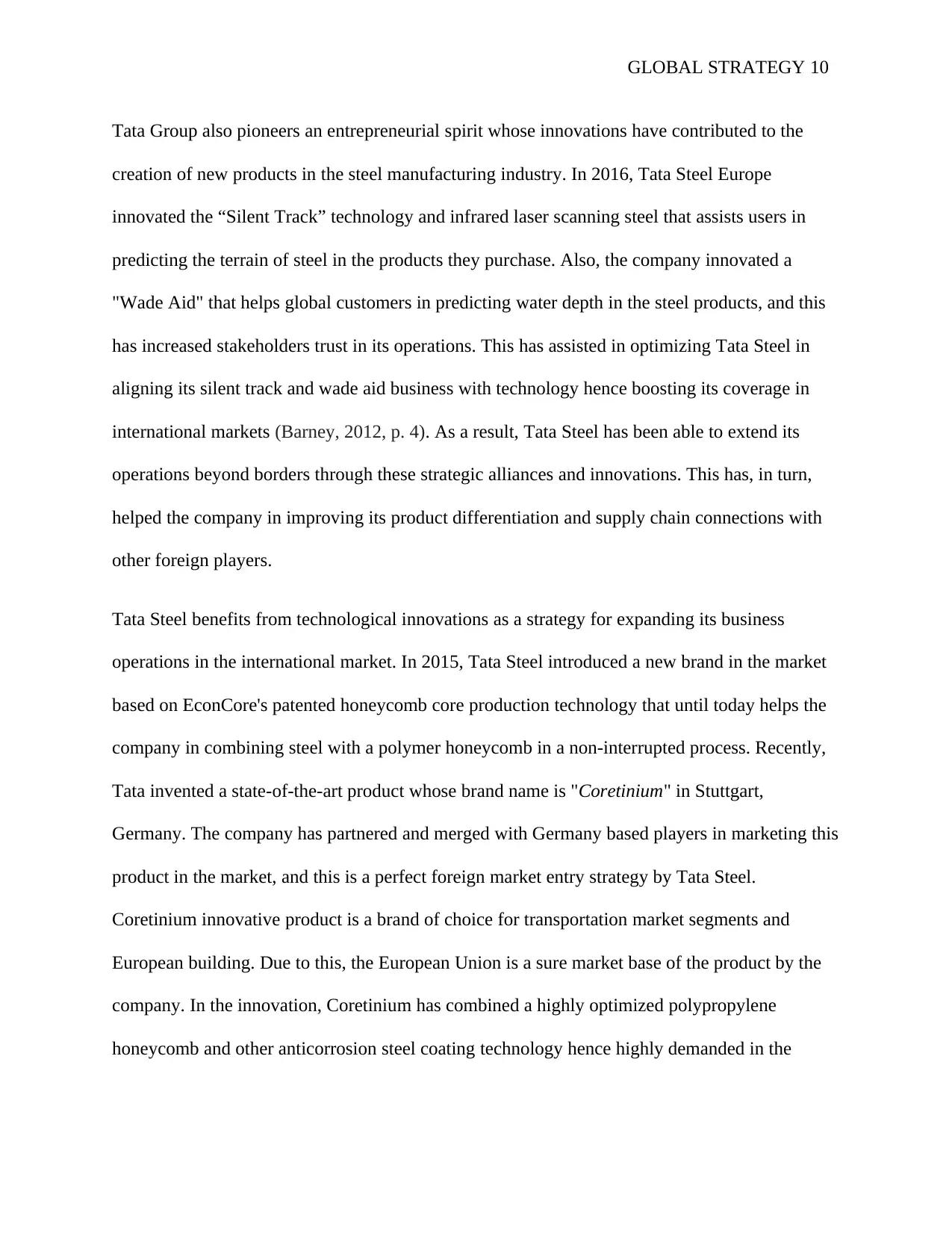
GLOBAL STRATEGY 10
Tata Group also pioneers an entrepreneurial spirit whose innovations have contributed to the
creation of new products in the steel manufacturing industry. In 2016, Tata Steel Europe
innovated the “Silent Track” technology and infrared laser scanning steel that assists users in
predicting the terrain of steel in the products they purchase. Also, the company innovated a
"Wade Aid" that helps global customers in predicting water depth in the steel products, and this
has increased stakeholders trust in its operations. This has assisted in optimizing Tata Steel in
aligning its silent track and wade aid business with technology hence boosting its coverage in
international markets (Barney, 2012, p. 4). As a result, Tata Steel has been able to extend its
operations beyond borders through these strategic alliances and innovations. This has, in turn,
helped the company in improving its product differentiation and supply chain connections with
other foreign players.
Tata Steel benefits from technological innovations as a strategy for expanding its business
operations in the international market. In 2015, Tata Steel introduced a new brand in the market
based on EconCore's patented honeycomb core production technology that until today helps the
company in combining steel with a polymer honeycomb in a non-interrupted process. Recently,
Tata invented a state-of-the-art product whose brand name is "Coretinium" in Stuttgart,
Germany. The company has partnered and merged with Germany based players in marketing this
product in the market, and this is a perfect foreign market entry strategy by Tata Steel.
Coretinium innovative product is a brand of choice for transportation market segments and
European building. Due to this, the European Union is a sure market base of the product by the
company. In the innovation, Coretinium has combined a highly optimized polypropylene
honeycomb and other anticorrosion steel coating technology hence highly demanded in the
Tata Group also pioneers an entrepreneurial spirit whose innovations have contributed to the
creation of new products in the steel manufacturing industry. In 2016, Tata Steel Europe
innovated the “Silent Track” technology and infrared laser scanning steel that assists users in
predicting the terrain of steel in the products they purchase. Also, the company innovated a
"Wade Aid" that helps global customers in predicting water depth in the steel products, and this
has increased stakeholders trust in its operations. This has assisted in optimizing Tata Steel in
aligning its silent track and wade aid business with technology hence boosting its coverage in
international markets (Barney, 2012, p. 4). As a result, Tata Steel has been able to extend its
operations beyond borders through these strategic alliances and innovations. This has, in turn,
helped the company in improving its product differentiation and supply chain connections with
other foreign players.
Tata Steel benefits from technological innovations as a strategy for expanding its business
operations in the international market. In 2015, Tata Steel introduced a new brand in the market
based on EconCore's patented honeycomb core production technology that until today helps the
company in combining steel with a polymer honeycomb in a non-interrupted process. Recently,
Tata invented a state-of-the-art product whose brand name is "Coretinium" in Stuttgart,
Germany. The company has partnered and merged with Germany based players in marketing this
product in the market, and this is a perfect foreign market entry strategy by Tata Steel.
Coretinium innovative product is a brand of choice for transportation market segments and
European building. Due to this, the European Union is a sure market base of the product by the
company. In the innovation, Coretinium has combined a highly optimized polypropylene
honeycomb and other anticorrosion steel coating technology hence highly demanded in the
Secure Best Marks with AI Grader
Need help grading? Try our AI Grader for instant feedback on your assignments.
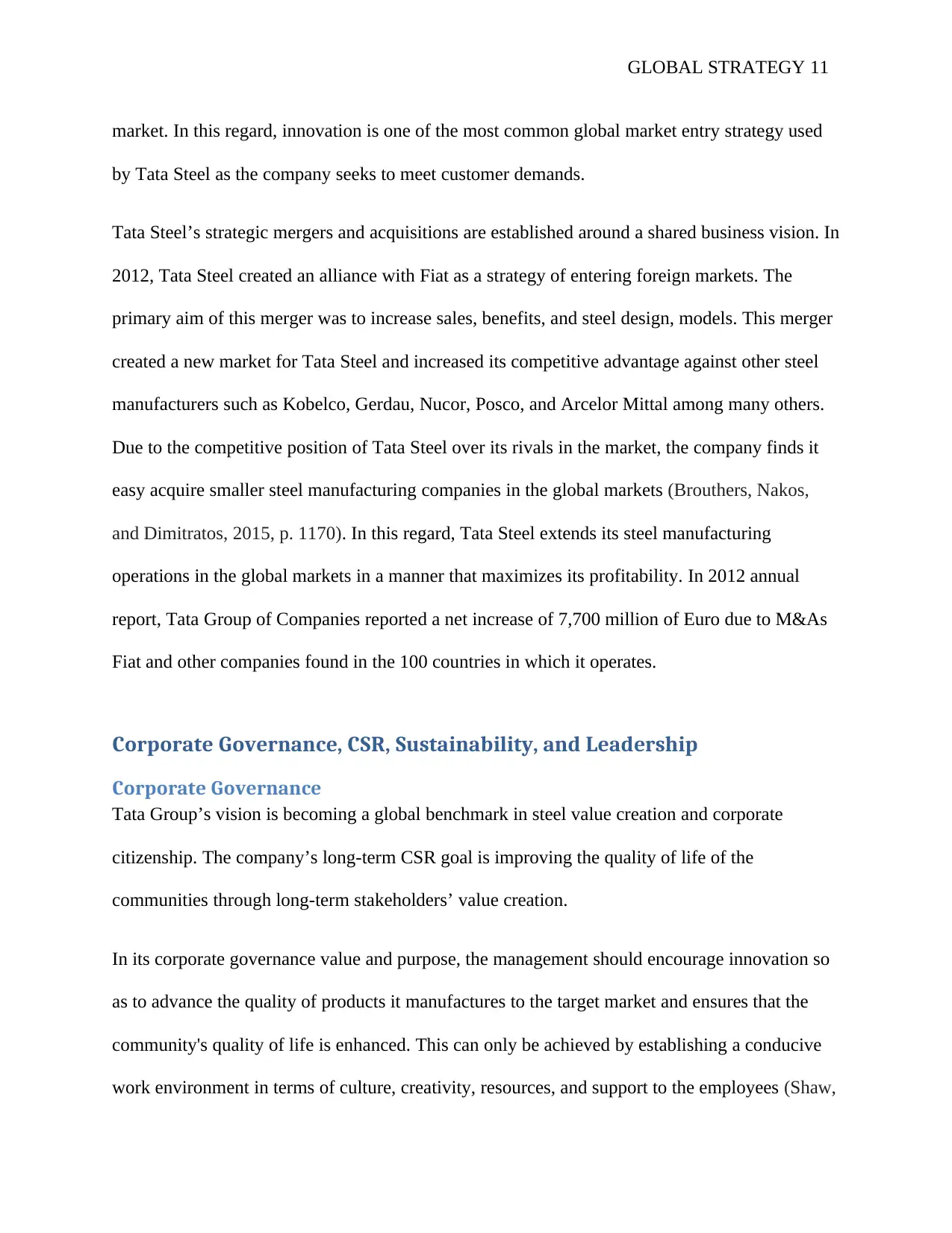
GLOBAL STRATEGY 11
market. In this regard, innovation is one of the most common global market entry strategy used
by Tata Steel as the company seeks to meet customer demands.
Tata Steel’s strategic mergers and acquisitions are established around a shared business vision. In
2012, Tata Steel created an alliance with Fiat as a strategy of entering foreign markets. The
primary aim of this merger was to increase sales, benefits, and steel design, models. This merger
created a new market for Tata Steel and increased its competitive advantage against other steel
manufacturers such as Kobelco, Gerdau, Nucor, Posco, and Arcelor Mittal among many others.
Due to the competitive position of Tata Steel over its rivals in the market, the company finds it
easy acquire smaller steel manufacturing companies in the global markets (Brouthers, Nakos,
and Dimitratos, 2015, p. 1170). In this regard, Tata Steel extends its steel manufacturing
operations in the global markets in a manner that maximizes its profitability. In 2012 annual
report, Tata Group of Companies reported a net increase of 7,700 million of Euro due to M&As
Fiat and other companies found in the 100 countries in which it operates.
Corporate Governance, CSR, Sustainability, and Leadership
Corporate Governance
Tata Group’s vision is becoming a global benchmark in steel value creation and corporate
citizenship. The company’s long-term CSR goal is improving the quality of life of the
communities through long-term stakeholders’ value creation.
In its corporate governance value and purpose, the management should encourage innovation so
as to advance the quality of products it manufactures to the target market and ensures that the
community's quality of life is enhanced. This can only be achieved by establishing a conducive
work environment in terms of culture, creativity, resources, and support to the employees (Shaw,
market. In this regard, innovation is one of the most common global market entry strategy used
by Tata Steel as the company seeks to meet customer demands.
Tata Steel’s strategic mergers and acquisitions are established around a shared business vision. In
2012, Tata Steel created an alliance with Fiat as a strategy of entering foreign markets. The
primary aim of this merger was to increase sales, benefits, and steel design, models. This merger
created a new market for Tata Steel and increased its competitive advantage against other steel
manufacturers such as Kobelco, Gerdau, Nucor, Posco, and Arcelor Mittal among many others.
Due to the competitive position of Tata Steel over its rivals in the market, the company finds it
easy acquire smaller steel manufacturing companies in the global markets (Brouthers, Nakos,
and Dimitratos, 2015, p. 1170). In this regard, Tata Steel extends its steel manufacturing
operations in the global markets in a manner that maximizes its profitability. In 2012 annual
report, Tata Group of Companies reported a net increase of 7,700 million of Euro due to M&As
Fiat and other companies found in the 100 countries in which it operates.
Corporate Governance, CSR, Sustainability, and Leadership
Corporate Governance
Tata Group’s vision is becoming a global benchmark in steel value creation and corporate
citizenship. The company’s long-term CSR goal is improving the quality of life of the
communities through long-term stakeholders’ value creation.
In its corporate governance value and purpose, the management should encourage innovation so
as to advance the quality of products it manufactures to the target market and ensures that the
community's quality of life is enhanced. This can only be achieved by establishing a conducive
work environment in terms of culture, creativity, resources, and support to the employees (Shaw,
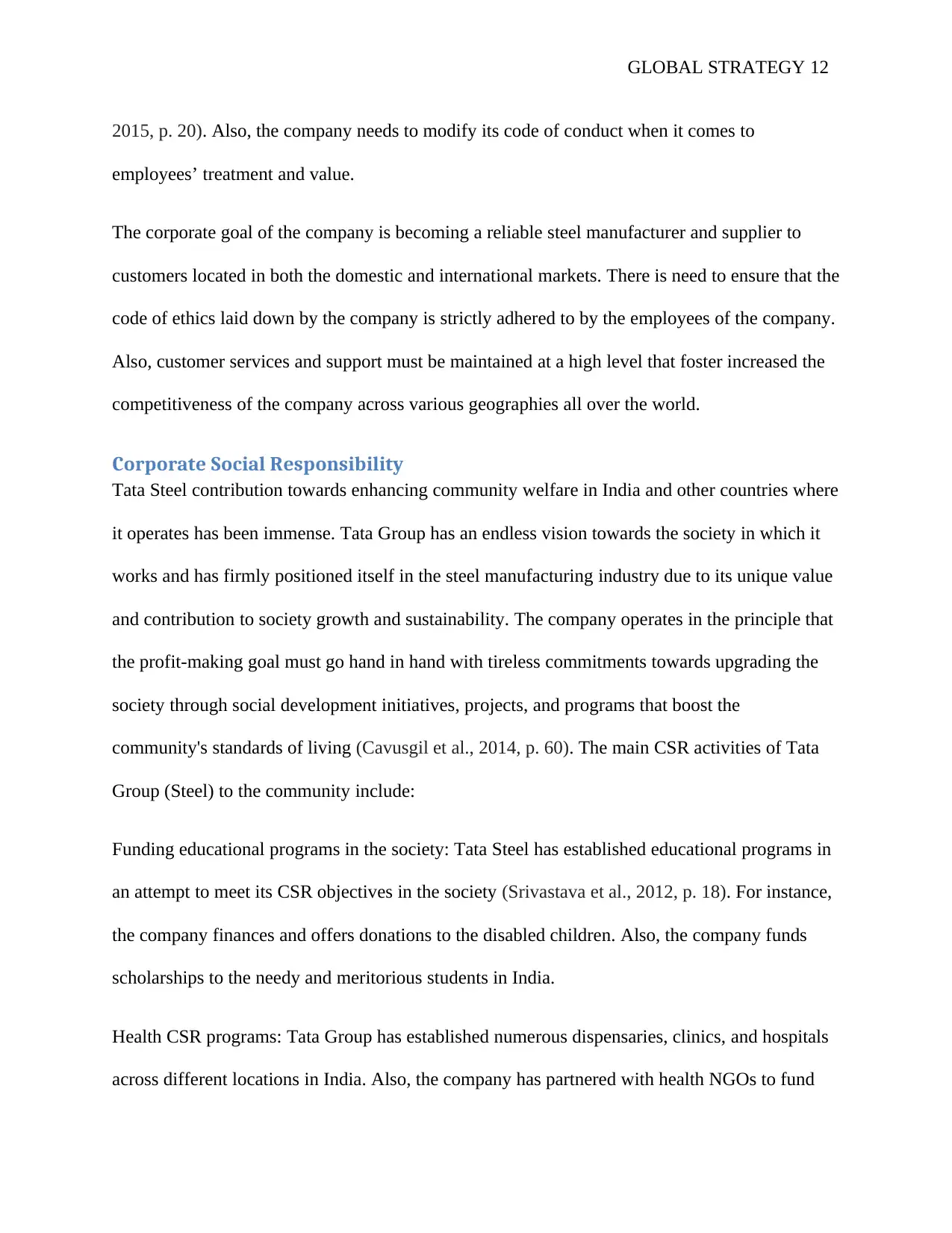
GLOBAL STRATEGY 12
2015, p. 20). Also, the company needs to modify its code of conduct when it comes to
employees’ treatment and value.
The corporate goal of the company is becoming a reliable steel manufacturer and supplier to
customers located in both the domestic and international markets. There is need to ensure that the
code of ethics laid down by the company is strictly adhered to by the employees of the company.
Also, customer services and support must be maintained at a high level that foster increased the
competitiveness of the company across various geographies all over the world.
Corporate Social Responsibility
Tata Steel contribution towards enhancing community welfare in India and other countries where
it operates has been immense. Tata Group has an endless vision towards the society in which it
works and has firmly positioned itself in the steel manufacturing industry due to its unique value
and contribution to society growth and sustainability. The company operates in the principle that
the profit-making goal must go hand in hand with tireless commitments towards upgrading the
society through social development initiatives, projects, and programs that boost the
community's standards of living (Cavusgil et al., 2014, p. 60). The main CSR activities of Tata
Group (Steel) to the community include:
Funding educational programs in the society: Tata Steel has established educational programs in
an attempt to meet its CSR objectives in the society (Srivastava et al., 2012, p. 18). For instance,
the company finances and offers donations to the disabled children. Also, the company funds
scholarships to the needy and meritorious students in India.
Health CSR programs: Tata Group has established numerous dispensaries, clinics, and hospitals
across different locations in India. Also, the company has partnered with health NGOs to fund
2015, p. 20). Also, the company needs to modify its code of conduct when it comes to
employees’ treatment and value.
The corporate goal of the company is becoming a reliable steel manufacturer and supplier to
customers located in both the domestic and international markets. There is need to ensure that the
code of ethics laid down by the company is strictly adhered to by the employees of the company.
Also, customer services and support must be maintained at a high level that foster increased the
competitiveness of the company across various geographies all over the world.
Corporate Social Responsibility
Tata Steel contribution towards enhancing community welfare in India and other countries where
it operates has been immense. Tata Group has an endless vision towards the society in which it
works and has firmly positioned itself in the steel manufacturing industry due to its unique value
and contribution to society growth and sustainability. The company operates in the principle that
the profit-making goal must go hand in hand with tireless commitments towards upgrading the
society through social development initiatives, projects, and programs that boost the
community's standards of living (Cavusgil et al., 2014, p. 60). The main CSR activities of Tata
Group (Steel) to the community include:
Funding educational programs in the society: Tata Steel has established educational programs in
an attempt to meet its CSR objectives in the society (Srivastava et al., 2012, p. 18). For instance,
the company finances and offers donations to the disabled children. Also, the company funds
scholarships to the needy and meritorious students in India.
Health CSR programs: Tata Group has established numerous dispensaries, clinics, and hospitals
across different locations in India. Also, the company has partnered with health NGOs to fund
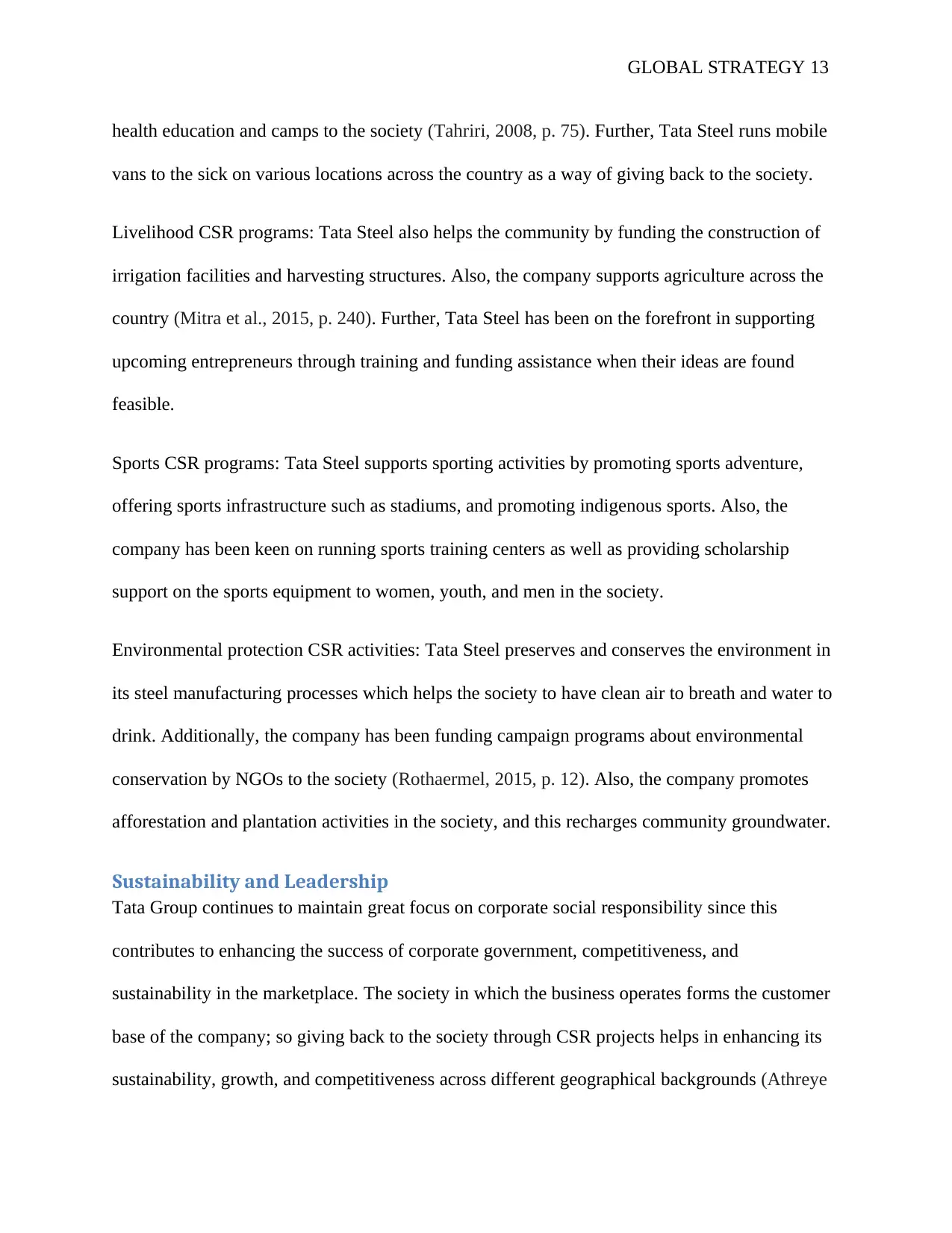
GLOBAL STRATEGY 13
health education and camps to the society (Tahriri, 2008, p. 75). Further, Tata Steel runs mobile
vans to the sick on various locations across the country as a way of giving back to the society.
Livelihood CSR programs: Tata Steel also helps the community by funding the construction of
irrigation facilities and harvesting structures. Also, the company supports agriculture across the
country (Mitra et al., 2015, p. 240). Further, Tata Steel has been on the forefront in supporting
upcoming entrepreneurs through training and funding assistance when their ideas are found
feasible.
Sports CSR programs: Tata Steel supports sporting activities by promoting sports adventure,
offering sports infrastructure such as stadiums, and promoting indigenous sports. Also, the
company has been keen on running sports training centers as well as providing scholarship
support on the sports equipment to women, youth, and men in the society.
Environmental protection CSR activities: Tata Steel preserves and conserves the environment in
its steel manufacturing processes which helps the society to have clean air to breath and water to
drink. Additionally, the company has been funding campaign programs about environmental
conservation by NGOs to the society (Rothaermel, 2015, p. 12). Also, the company promotes
afforestation and plantation activities in the society, and this recharges community groundwater.
Sustainability and Leadership
Tata Group continues to maintain great focus on corporate social responsibility since this
contributes to enhancing the success of corporate government, competitiveness, and
sustainability in the marketplace. The society in which the business operates forms the customer
base of the company; so giving back to the society through CSR projects helps in enhancing its
sustainability, growth, and competitiveness across different geographical backgrounds (Athreye
health education and camps to the society (Tahriri, 2008, p. 75). Further, Tata Steel runs mobile
vans to the sick on various locations across the country as a way of giving back to the society.
Livelihood CSR programs: Tata Steel also helps the community by funding the construction of
irrigation facilities and harvesting structures. Also, the company supports agriculture across the
country (Mitra et al., 2015, p. 240). Further, Tata Steel has been on the forefront in supporting
upcoming entrepreneurs through training and funding assistance when their ideas are found
feasible.
Sports CSR programs: Tata Steel supports sporting activities by promoting sports adventure,
offering sports infrastructure such as stadiums, and promoting indigenous sports. Also, the
company has been keen on running sports training centers as well as providing scholarship
support on the sports equipment to women, youth, and men in the society.
Environmental protection CSR activities: Tata Steel preserves and conserves the environment in
its steel manufacturing processes which helps the society to have clean air to breath and water to
drink. Additionally, the company has been funding campaign programs about environmental
conservation by NGOs to the society (Rothaermel, 2015, p. 12). Also, the company promotes
afforestation and plantation activities in the society, and this recharges community groundwater.
Sustainability and Leadership
Tata Group continues to maintain great focus on corporate social responsibility since this
contributes to enhancing the success of corporate government, competitiveness, and
sustainability in the marketplace. The society in which the business operates forms the customer
base of the company; so giving back to the society through CSR projects helps in enhancing its
sustainability, growth, and competitiveness across different geographical backgrounds (Athreye
Paraphrase This Document
Need a fresh take? Get an instant paraphrase of this document with our AI Paraphraser
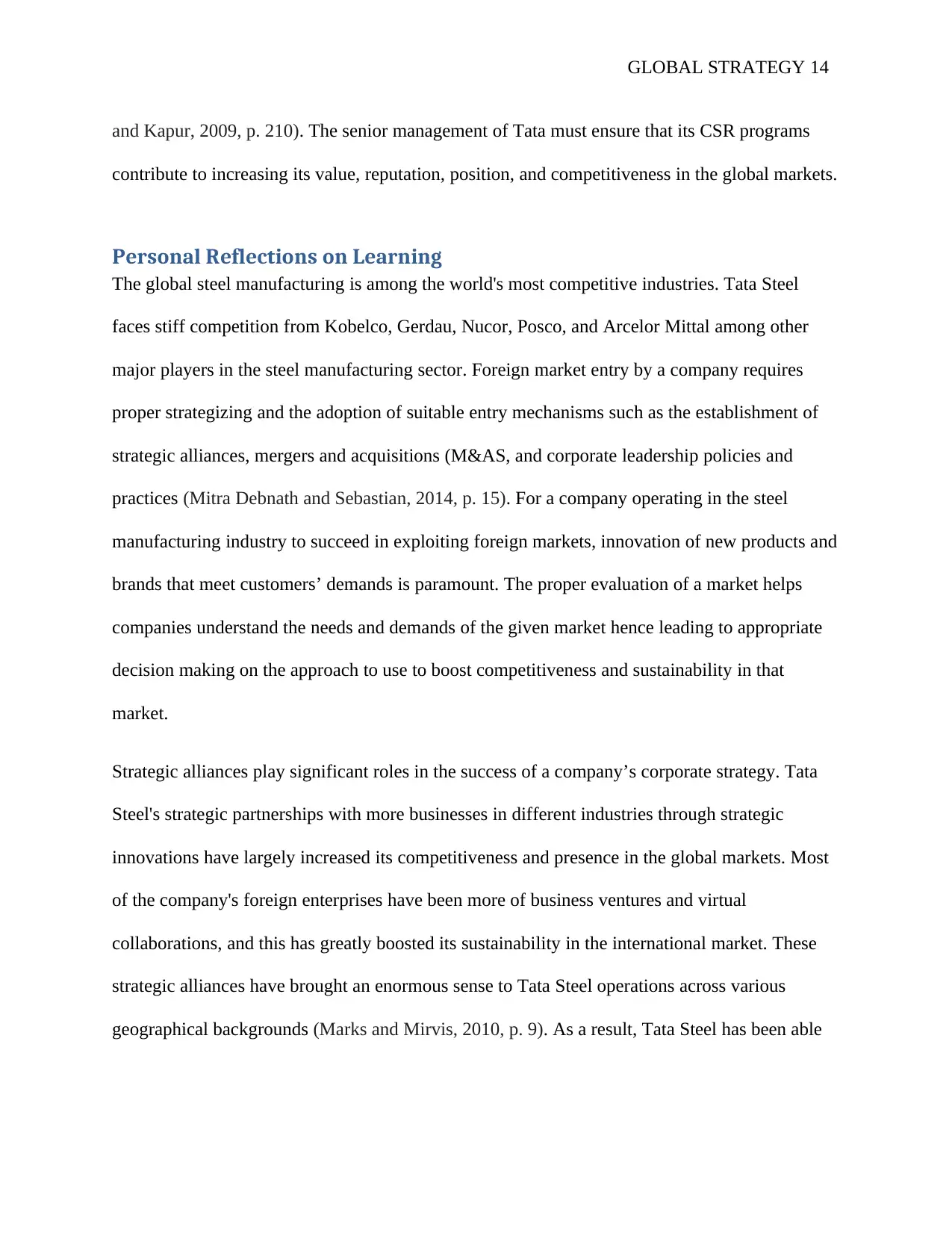
GLOBAL STRATEGY 14
and Kapur, 2009, p. 210). The senior management of Tata must ensure that its CSR programs
contribute to increasing its value, reputation, position, and competitiveness in the global markets.
Personal Reflections on Learning
The global steel manufacturing is among the world's most competitive industries. Tata Steel
faces stiff competition from Kobelco, Gerdau, Nucor, Posco, and Arcelor Mittal among other
major players in the steel manufacturing sector. Foreign market entry by a company requires
proper strategizing and the adoption of suitable entry mechanisms such as the establishment of
strategic alliances, mergers and acquisitions (M&AS, and corporate leadership policies and
practices (Mitra Debnath and Sebastian, 2014, p. 15). For a company operating in the steel
manufacturing industry to succeed in exploiting foreign markets, innovation of new products and
brands that meet customers’ demands is paramount. The proper evaluation of a market helps
companies understand the needs and demands of the given market hence leading to appropriate
decision making on the approach to use to boost competitiveness and sustainability in that
market.
Strategic alliances play significant roles in the success of a company’s corporate strategy. Tata
Steel's strategic partnerships with more businesses in different industries through strategic
innovations have largely increased its competitiveness and presence in the global markets. Most
of the company's foreign enterprises have been more of business ventures and virtual
collaborations, and this has greatly boosted its sustainability in the international market. These
strategic alliances have brought an enormous sense to Tata Steel operations across various
geographical backgrounds (Marks and Mirvis, 2010, p. 9). As a result, Tata Steel has been able
and Kapur, 2009, p. 210). The senior management of Tata must ensure that its CSR programs
contribute to increasing its value, reputation, position, and competitiveness in the global markets.
Personal Reflections on Learning
The global steel manufacturing is among the world's most competitive industries. Tata Steel
faces stiff competition from Kobelco, Gerdau, Nucor, Posco, and Arcelor Mittal among other
major players in the steel manufacturing sector. Foreign market entry by a company requires
proper strategizing and the adoption of suitable entry mechanisms such as the establishment of
strategic alliances, mergers and acquisitions (M&AS, and corporate leadership policies and
practices (Mitra Debnath and Sebastian, 2014, p. 15). For a company operating in the steel
manufacturing industry to succeed in exploiting foreign markets, innovation of new products and
brands that meet customers’ demands is paramount. The proper evaluation of a market helps
companies understand the needs and demands of the given market hence leading to appropriate
decision making on the approach to use to boost competitiveness and sustainability in that
market.
Strategic alliances play significant roles in the success of a company’s corporate strategy. Tata
Steel's strategic partnerships with more businesses in different industries through strategic
innovations have largely increased its competitiveness and presence in the global markets. Most
of the company's foreign enterprises have been more of business ventures and virtual
collaborations, and this has greatly boosted its sustainability in the international market. These
strategic alliances have brought an enormous sense to Tata Steel operations across various
geographical backgrounds (Marks and Mirvis, 2010, p. 9). As a result, Tata Steel has been able
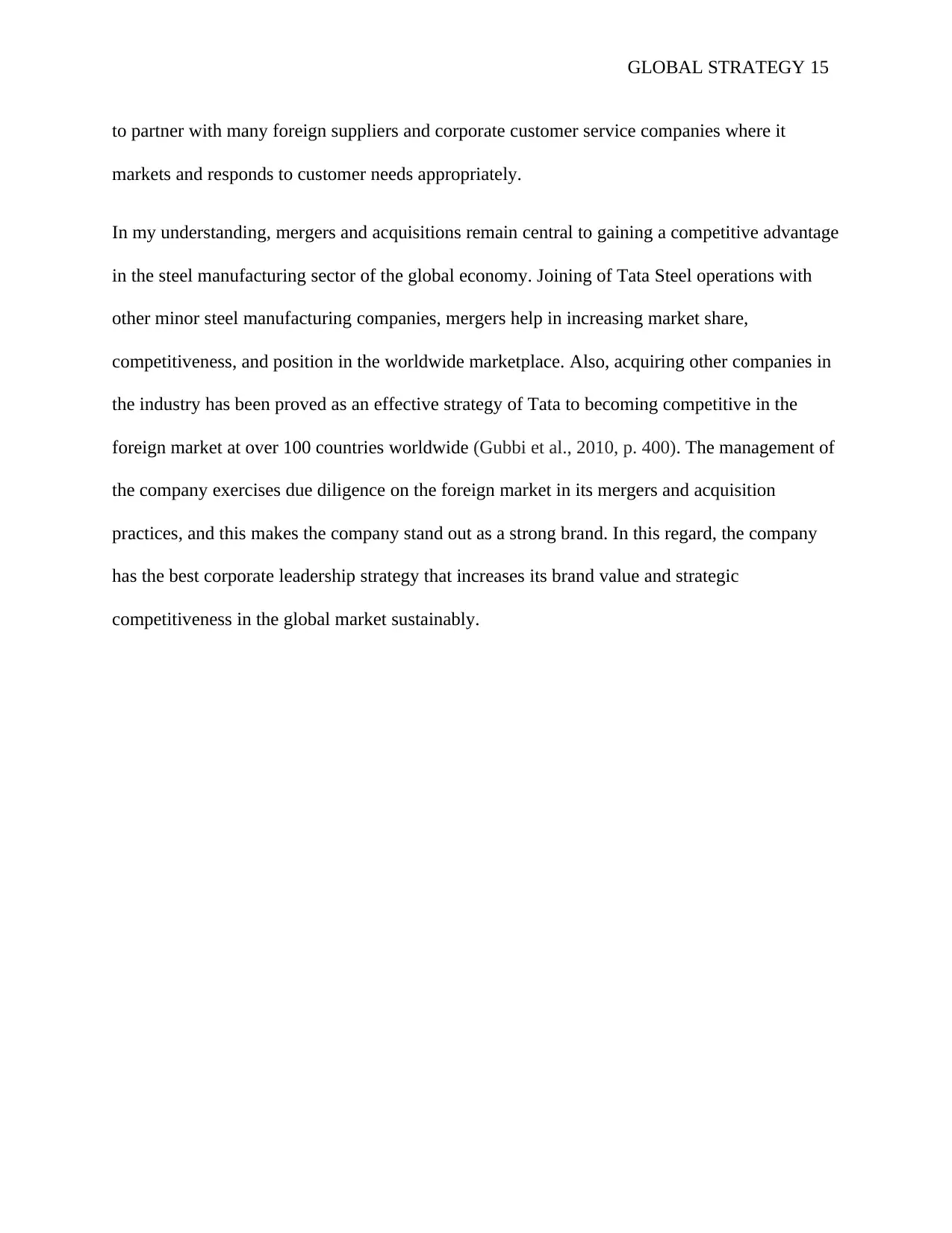
GLOBAL STRATEGY 15
to partner with many foreign suppliers and corporate customer service companies where it
markets and responds to customer needs appropriately.
In my understanding, mergers and acquisitions remain central to gaining a competitive advantage
in the steel manufacturing sector of the global economy. Joining of Tata Steel operations with
other minor steel manufacturing companies, mergers help in increasing market share,
competitiveness, and position in the worldwide marketplace. Also, acquiring other companies in
the industry has been proved as an effective strategy of Tata to becoming competitive in the
foreign market at over 100 countries worldwide (Gubbi et al., 2010, p. 400). The management of
the company exercises due diligence on the foreign market in its mergers and acquisition
practices, and this makes the company stand out as a strong brand. In this regard, the company
has the best corporate leadership strategy that increases its brand value and strategic
competitiveness in the global market sustainably.
to partner with many foreign suppliers and corporate customer service companies where it
markets and responds to customer needs appropriately.
In my understanding, mergers and acquisitions remain central to gaining a competitive advantage
in the steel manufacturing sector of the global economy. Joining of Tata Steel operations with
other minor steel manufacturing companies, mergers help in increasing market share,
competitiveness, and position in the worldwide marketplace. Also, acquiring other companies in
the industry has been proved as an effective strategy of Tata to becoming competitive in the
foreign market at over 100 countries worldwide (Gubbi et al., 2010, p. 400). The management of
the company exercises due diligence on the foreign market in its mergers and acquisition
practices, and this makes the company stand out as a strong brand. In this regard, the company
has the best corporate leadership strategy that increases its brand value and strategic
competitiveness in the global market sustainably.
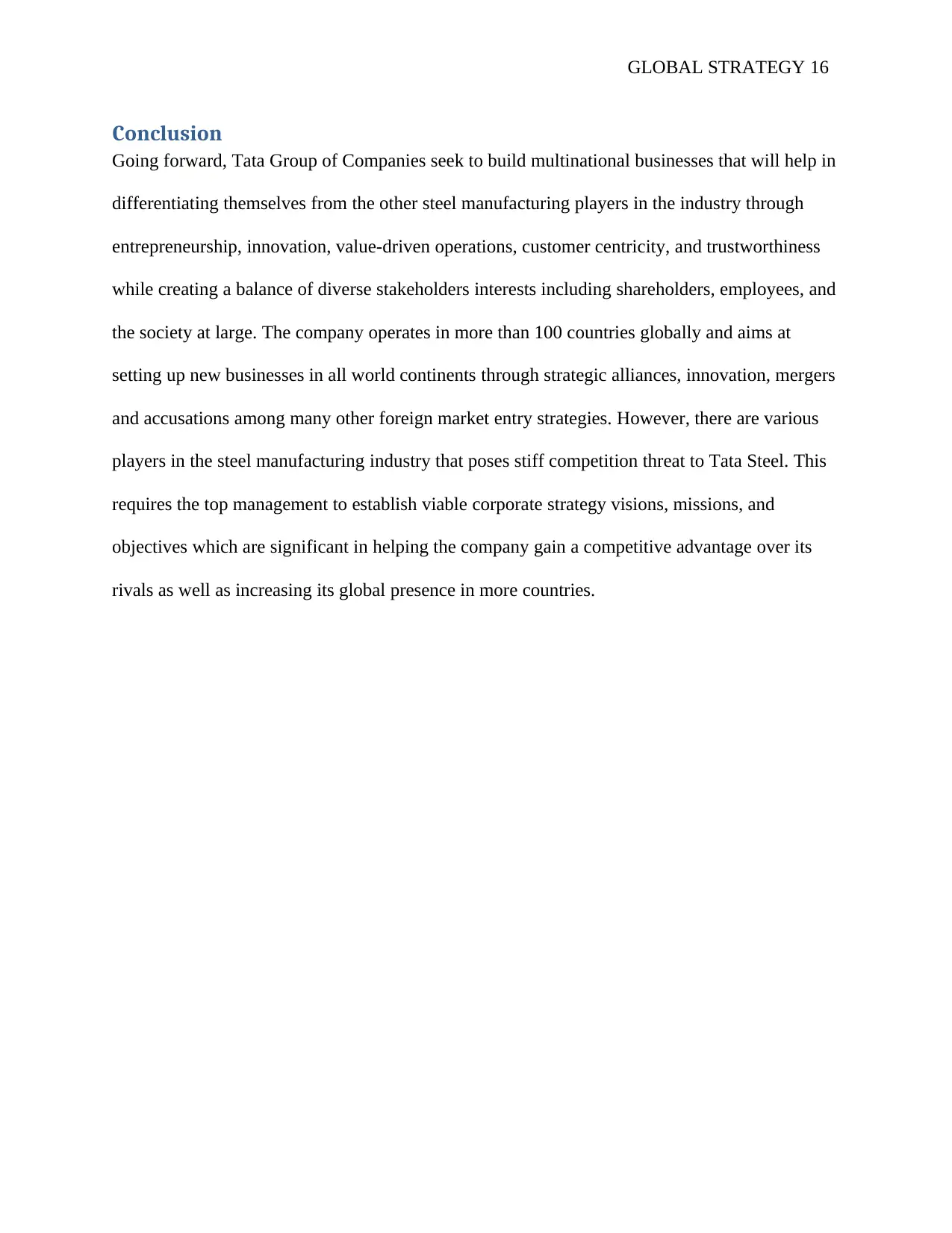
GLOBAL STRATEGY 16
Conclusion
Going forward, Tata Group of Companies seek to build multinational businesses that will help in
differentiating themselves from the other steel manufacturing players in the industry through
entrepreneurship, innovation, value-driven operations, customer centricity, and trustworthiness
while creating a balance of diverse stakeholders interests including shareholders, employees, and
the society at large. The company operates in more than 100 countries globally and aims at
setting up new businesses in all world continents through strategic alliances, innovation, mergers
and accusations among many other foreign market entry strategies. However, there are various
players in the steel manufacturing industry that poses stiff competition threat to Tata Steel. This
requires the top management to establish viable corporate strategy visions, missions, and
objectives which are significant in helping the company gain a competitive advantage over its
rivals as well as increasing its global presence in more countries.
Conclusion
Going forward, Tata Group of Companies seek to build multinational businesses that will help in
differentiating themselves from the other steel manufacturing players in the industry through
entrepreneurship, innovation, value-driven operations, customer centricity, and trustworthiness
while creating a balance of diverse stakeholders interests including shareholders, employees, and
the society at large. The company operates in more than 100 countries globally and aims at
setting up new businesses in all world continents through strategic alliances, innovation, mergers
and accusations among many other foreign market entry strategies. However, there are various
players in the steel manufacturing industry that poses stiff competition threat to Tata Steel. This
requires the top management to establish viable corporate strategy visions, missions, and
objectives which are significant in helping the company gain a competitive advantage over its
rivals as well as increasing its global presence in more countries.
Secure Best Marks with AI Grader
Need help grading? Try our AI Grader for instant feedback on your assignments.
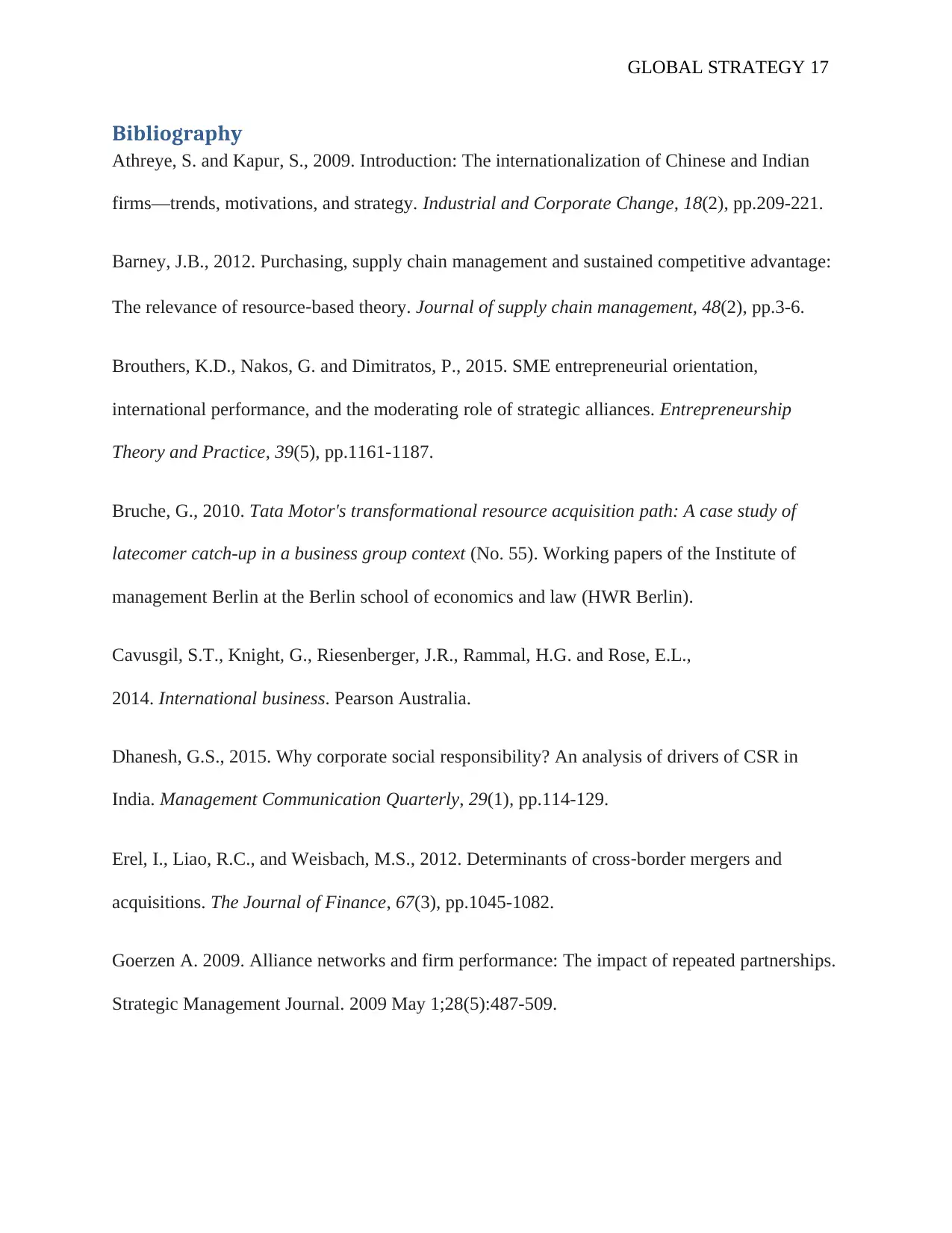
GLOBAL STRATEGY 17
Bibliography
Athreye, S. and Kapur, S., 2009. Introduction: The internationalization of Chinese and Indian
firms—trends, motivations, and strategy. Industrial and Corporate Change, 18(2), pp.209-221.
Barney, J.B., 2012. Purchasing, supply chain management and sustained competitive advantage:
The relevance of resource‐based theory. Journal of supply chain management, 48(2), pp.3-6.
Brouthers, K.D., Nakos, G. and Dimitratos, P., 2015. SME entrepreneurial orientation,
international performance, and the moderating role of strategic alliances. Entrepreneurship
Theory and Practice, 39(5), pp.1161-1187.
Bruche, G., 2010. Tata Motor's transformational resource acquisition path: A case study of
latecomer catch-up in a business group context (No. 55). Working papers of the Institute of
management Berlin at the Berlin school of economics and law (HWR Berlin).
Cavusgil, S.T., Knight, G., Riesenberger, J.R., Rammal, H.G. and Rose, E.L.,
2014. International business. Pearson Australia.
Dhanesh, G.S., 2015. Why corporate social responsibility? An analysis of drivers of CSR in
India. Management Communication Quarterly, 29(1), pp.114-129.
Erel, I., Liao, R.C., and Weisbach, M.S., 2012. Determinants of cross‐border mergers and
acquisitions. The Journal of Finance, 67(3), pp.1045-1082.
Goerzen A. 2009. Alliance networks and firm performance: The impact of repeated partnerships.
Strategic Management Journal. 2009 May 1;28(5):487-509.
Bibliography
Athreye, S. and Kapur, S., 2009. Introduction: The internationalization of Chinese and Indian
firms—trends, motivations, and strategy. Industrial and Corporate Change, 18(2), pp.209-221.
Barney, J.B., 2012. Purchasing, supply chain management and sustained competitive advantage:
The relevance of resource‐based theory. Journal of supply chain management, 48(2), pp.3-6.
Brouthers, K.D., Nakos, G. and Dimitratos, P., 2015. SME entrepreneurial orientation,
international performance, and the moderating role of strategic alliances. Entrepreneurship
Theory and Practice, 39(5), pp.1161-1187.
Bruche, G., 2010. Tata Motor's transformational resource acquisition path: A case study of
latecomer catch-up in a business group context (No. 55). Working papers of the Institute of
management Berlin at the Berlin school of economics and law (HWR Berlin).
Cavusgil, S.T., Knight, G., Riesenberger, J.R., Rammal, H.G. and Rose, E.L.,
2014. International business. Pearson Australia.
Dhanesh, G.S., 2015. Why corporate social responsibility? An analysis of drivers of CSR in
India. Management Communication Quarterly, 29(1), pp.114-129.
Erel, I., Liao, R.C., and Weisbach, M.S., 2012. Determinants of cross‐border mergers and
acquisitions. The Journal of Finance, 67(3), pp.1045-1082.
Goerzen A. 2009. Alliance networks and firm performance: The impact of repeated partnerships.
Strategic Management Journal. 2009 May 1;28(5):487-509.
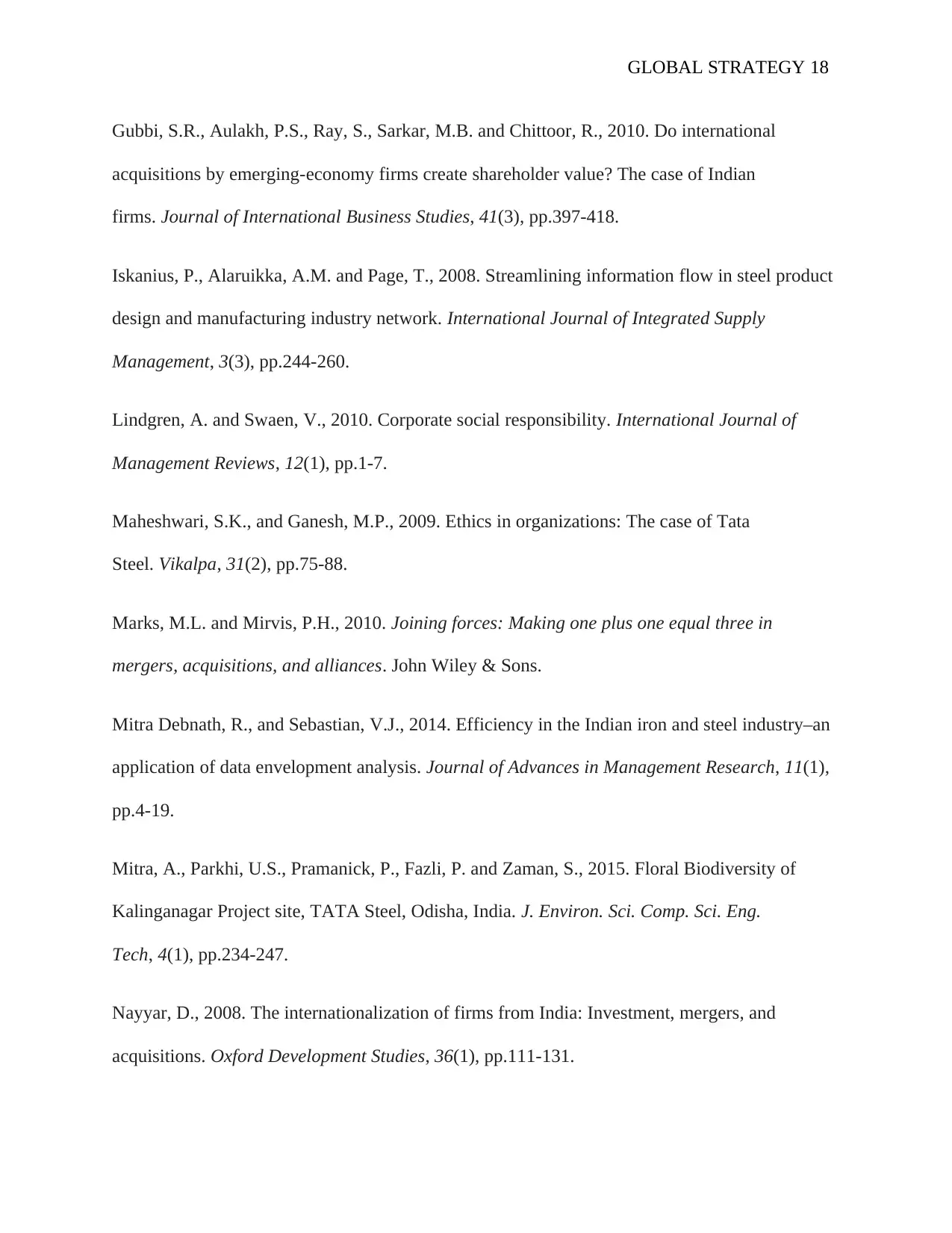
GLOBAL STRATEGY 18
Gubbi, S.R., Aulakh, P.S., Ray, S., Sarkar, M.B. and Chittoor, R., 2010. Do international
acquisitions by emerging-economy firms create shareholder value? The case of Indian
firms. Journal of International Business Studies, 41(3), pp.397-418.
Iskanius, P., Alaruikka, A.M. and Page, T., 2008. Streamlining information flow in steel product
design and manufacturing industry network. International Journal of Integrated Supply
Management, 3(3), pp.244-260.
Lindgren, A. and Swaen, V., 2010. Corporate social responsibility. International Journal of
Management Reviews, 12(1), pp.1-7.
Maheshwari, S.K., and Ganesh, M.P., 2009. Ethics in organizations: The case of Tata
Steel. Vikalpa, 31(2), pp.75-88.
Marks, M.L. and Mirvis, P.H., 2010. Joining forces: Making one plus one equal three in
mergers, acquisitions, and alliances. John Wiley & Sons.
Mitra Debnath, R., and Sebastian, V.J., 2014. Efficiency in the Indian iron and steel industry–an
application of data envelopment analysis. Journal of Advances in Management Research, 11(1),
pp.4-19.
Mitra, A., Parkhi, U.S., Pramanick, P., Fazli, P. and Zaman, S., 2015. Floral Biodiversity of
Kalinganagar Project site, TATA Steel, Odisha, India. J. Environ. Sci. Comp. Sci. Eng.
Tech, 4(1), pp.234-247.
Nayyar, D., 2008. The internationalization of firms from India: Investment, mergers, and
acquisitions. Oxford Development Studies, 36(1), pp.111-131.
Gubbi, S.R., Aulakh, P.S., Ray, S., Sarkar, M.B. and Chittoor, R., 2010. Do international
acquisitions by emerging-economy firms create shareholder value? The case of Indian
firms. Journal of International Business Studies, 41(3), pp.397-418.
Iskanius, P., Alaruikka, A.M. and Page, T., 2008. Streamlining information flow in steel product
design and manufacturing industry network. International Journal of Integrated Supply
Management, 3(3), pp.244-260.
Lindgren, A. and Swaen, V., 2010. Corporate social responsibility. International Journal of
Management Reviews, 12(1), pp.1-7.
Maheshwari, S.K., and Ganesh, M.P., 2009. Ethics in organizations: The case of Tata
Steel. Vikalpa, 31(2), pp.75-88.
Marks, M.L. and Mirvis, P.H., 2010. Joining forces: Making one plus one equal three in
mergers, acquisitions, and alliances. John Wiley & Sons.
Mitra Debnath, R., and Sebastian, V.J., 2014. Efficiency in the Indian iron and steel industry–an
application of data envelopment analysis. Journal of Advances in Management Research, 11(1),
pp.4-19.
Mitra, A., Parkhi, U.S., Pramanick, P., Fazli, P. and Zaman, S., 2015. Floral Biodiversity of
Kalinganagar Project site, TATA Steel, Odisha, India. J. Environ. Sci. Comp. Sci. Eng.
Tech, 4(1), pp.234-247.
Nayyar, D., 2008. The internationalization of firms from India: Investment, mergers, and
acquisitions. Oxford Development Studies, 36(1), pp.111-131.
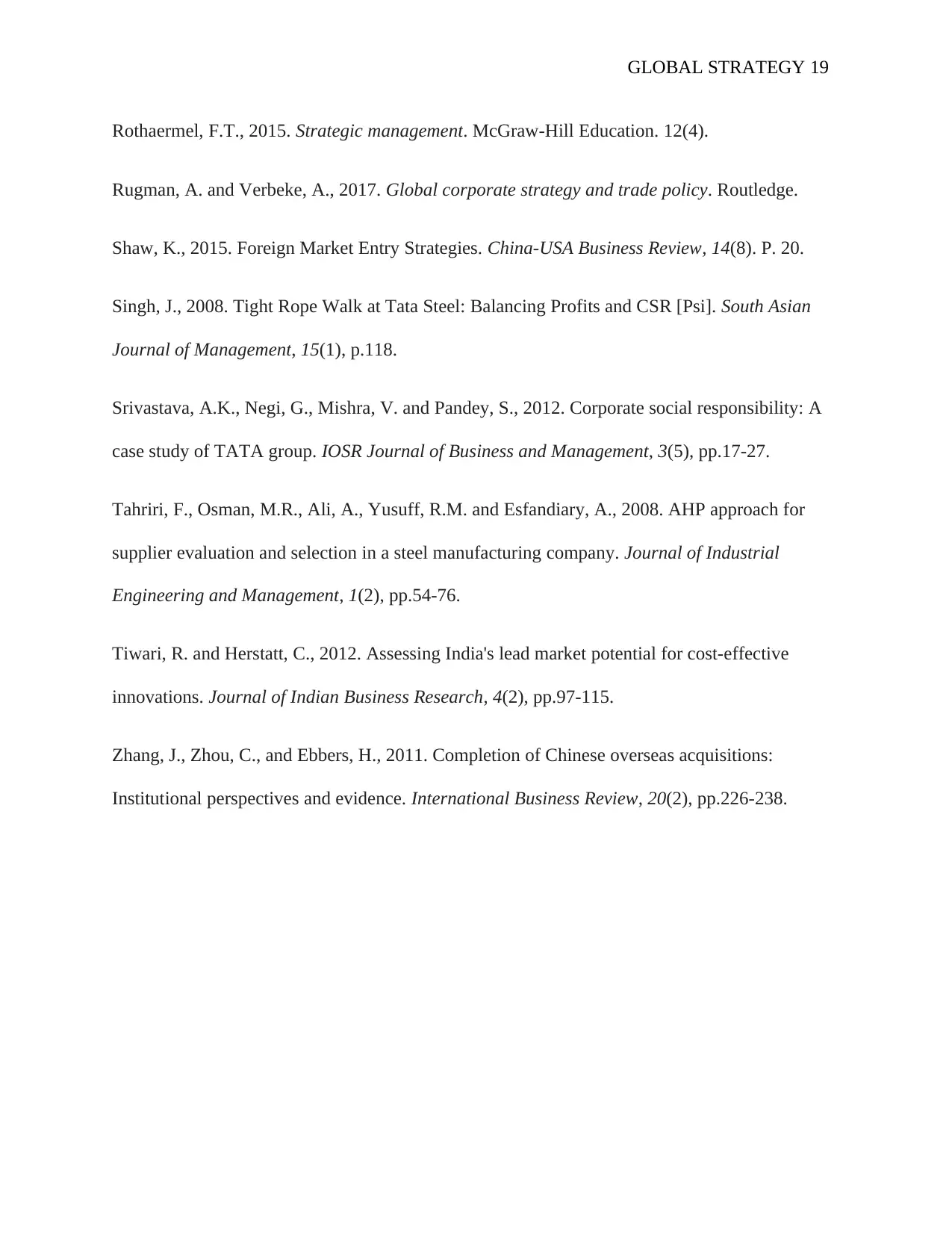
GLOBAL STRATEGY 19
Rothaermel, F.T., 2015. Strategic management. McGraw-Hill Education. 12(4).
Rugman, A. and Verbeke, A., 2017. Global corporate strategy and trade policy. Routledge.
Shaw, K., 2015. Foreign Market Entry Strategies. China-USA Business Review, 14(8). P. 20.
Singh, J., 2008. Tight Rope Walk at Tata Steel: Balancing Profits and CSR [Psi]. South Asian
Journal of Management, 15(1), p.118.
Srivastava, A.K., Negi, G., Mishra, V. and Pandey, S., 2012. Corporate social responsibility: A
case study of TATA group. IOSR Journal of Business and Management, 3(5), pp.17-27.
Tahriri, F., Osman, M.R., Ali, A., Yusuff, R.M. and Esfandiary, A., 2008. AHP approach for
supplier evaluation and selection in a steel manufacturing company. Journal of Industrial
Engineering and Management, 1(2), pp.54-76.
Tiwari, R. and Herstatt, C., 2012. Assessing India's lead market potential for cost-effective
innovations. Journal of Indian Business Research, 4(2), pp.97-115.
Zhang, J., Zhou, C., and Ebbers, H., 2011. Completion of Chinese overseas acquisitions:
Institutional perspectives and evidence. International Business Review, 20(2), pp.226-238.
Rothaermel, F.T., 2015. Strategic management. McGraw-Hill Education. 12(4).
Rugman, A. and Verbeke, A., 2017. Global corporate strategy and trade policy. Routledge.
Shaw, K., 2015. Foreign Market Entry Strategies. China-USA Business Review, 14(8). P. 20.
Singh, J., 2008. Tight Rope Walk at Tata Steel: Balancing Profits and CSR [Psi]. South Asian
Journal of Management, 15(1), p.118.
Srivastava, A.K., Negi, G., Mishra, V. and Pandey, S., 2012. Corporate social responsibility: A
case study of TATA group. IOSR Journal of Business and Management, 3(5), pp.17-27.
Tahriri, F., Osman, M.R., Ali, A., Yusuff, R.M. and Esfandiary, A., 2008. AHP approach for
supplier evaluation and selection in a steel manufacturing company. Journal of Industrial
Engineering and Management, 1(2), pp.54-76.
Tiwari, R. and Herstatt, C., 2012. Assessing India's lead market potential for cost-effective
innovations. Journal of Indian Business Research, 4(2), pp.97-115.
Zhang, J., Zhou, C., and Ebbers, H., 2011. Completion of Chinese overseas acquisitions:
Institutional perspectives and evidence. International Business Review, 20(2), pp.226-238.
1 out of 19
Related Documents
Your All-in-One AI-Powered Toolkit for Academic Success.
+13062052269
info@desklib.com
Available 24*7 on WhatsApp / Email
![[object Object]](/_next/static/media/star-bottom.7253800d.svg)
Unlock your academic potential
© 2024 | Zucol Services PVT LTD | All rights reserved.




